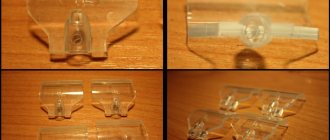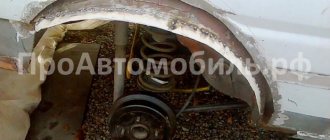Is it necessary to insulate the battery in a car in winter?
There is a belief that when it gets cold, it is necessary to insulate everything in the car - they say, this way the engine will cool down longer (and warm up faster), and the cabin will be warmer and more comfortable.
Someone goes further and insulates the radiator with battery, gas tank, fuel line, etc. Today we will talk about how to insulate a battery for the winter, how this can be done, which insulation methods are preferable, and whether insulation of the battery is necessary at all. Before we talk about what can be used for insulation, let's look at the question of whether it is necessary to insulate the battery at all. To do this, let's touch on a little theory.
Quick navigation through the article
Why do you need battery insulation?
Everyone knows that batteries love heat. Owners of iPhones and other Apple brand products especially notice this. The fact is that at low temperatures, lithium-polymer batteries begin to discharge quickly. Therefore, their owners try to minimize the use of all kinds of electronic gadgets in the cold.
The operating mode of the battery is a discharge-charge process. During discharge, the battery operates as a current source, and during charging, it acts as an energy consumer.
At temperatures of +10..+25 degrees in lead batteries, the chemical process is as active as possible. And since the chemical process creates a potential difference on the plates, the more active the chemical process, the better its performance: higher voltage, higher capacity, shorter charging time.
In the case when the car is actively used, battery storage is the time the car is idle with the engine turned off, during which the load on the battery is reduced as much as possible (all devices are turned off except for some, for example, the alarm system).
In order to maintain the optimal temperature range for high-quality operation and storage, I believe that it is necessary to insulate the battery in the car. It will last longer, definitely.
Insulation with foil insulation
Folgoizol is a flexible and comfortable material that guarantees the user high-quality thermal insulation. To ensure higher efficiency, it is recommended to use three layers of insulator.
Algorithm of actions for independent construction of insulation:
- The user needs to take measurements corresponding to the dimensions of the battery.
- Then, parts of the insulating case are cut out of foil insulation using scissors or a stationery knife.
- To provide additional protection from external factors, foam should be used. Pieces of appropriate sizes are also cut out of this material; its thickness should be about 2 cm. Foam plastic will be used as the middle layer of insulating material.
- Folgoizol is also used as the third, outer layer.
- It is recommended to connect the foam walls with glue, and foil insulation is fixed with tape. The tank lid is made using a similar principle. Then you need to install the thermal case on the battery and make sure that the dimensions are correct. The main disadvantage of such a reservoir is that heat from the engine will not flow to the battery, and this can lead to a poor-quality charge.
How can you insulate a battery?
So, it remains to understand how you can insulate a car battery in winter. There are two options: use ready-made solutions or insulate the car battery yourself.
Ready solutions
In fact, a solution to the question of how to insulate a battery in the cold season has been on the market for quite some time. There are two options: a thermal case and a heated thermal case. Both solutions are good, but the second option (with heating) is definitely better, although it costs more.
Thermal cases
Thermal case is a rectangular case with a lid, the walls of which are made of thermal insulation material, placed in a protective fabric.
Almost any heat insulator can act as a thermal insulating filler, but most often foil insulation or other foamed polyethylene is used in industrially manufactured products. The fabric used to cover the thermal layer must be resistant to temperature changes and the effects of various substances: acid, gasoline, oil, coolant and brake fluids. In addition, it must have water-repellent properties.
Thermal cases on the market are almost all made using materials that meet the above requirements. Their cost starts from about 900 rubles and depends, first of all, on the size of the battery.
Heated thermal cases
A heated thermal case is the same case, but additionally has heating elements shaped like plates.
Why plates and not shadows, for example? Firstly, this form factor of the heating element provides maximum heating area, and secondly, fire safety.
Thermal case heating elements are almost always equipped with battery charge and temperature controllers. Just like the thermal case itself, the heating system is resistant to operating fluids.
The cost of heating elements for a battery thermal case on the market starts from 2000 rubles. The price depends on the size of the battery and its parameters.
With your own hands
You can also insulate a car battery in winter yourself. There is nothing complicated about this. By the way, there are also two options: the first is to use a so-called car blanket, the second is to make a thermal case yourself. Although, you can also buy a car blanket or make it yourself. In general, that's not the point.
Using a car blanket
You probably already have it and are already using it. Then consider that the battery is insulated - the entire engine compartment is covered with this thing. Consequently, the battery will cool down along with the engine.
On the one hand, it is advisable to cover the engine compartment - after all, after a long trip, the engine is at a high temperature, and under the hood you can use a car blanket to keep it warm for a while. And the most important advantage of this method is that the battery begins to heat up along with the engine, nothing interferes with it, so the question of how to warm the battery in a car in winter simply does not arise.
On the other hand, the method of thermal insulation of the battery together with the engine is significantly inferior to the thermal case, because Heat dissipation after stopping the engine occurs much faster, which means that the battery cools down more actively than if it had its own thermal box.
Unusual ways to insulate batteries
Interesting methods of insulation include:
- "cooler";
- on-board network;
- nichrome thread;
- factory insulation.
Heating with a cooler
Many people know how the engine is heated - by circulating antifreeze through special channels. Here we will look at a similar system when a branch is made from the stove or from another place. Several or one tube is made from it, encircling the battery. The antifreeze is heated instantly and circulates around the battery.
Such a system is very rare; additional work is required to lay the pipeline. Moreover, removing the battery will be labor-intensive. Moreover, in this way, it is quite possible to even overheat the battery. In this case, the electrolyte will boil, and subsequent actions are simply impossible to predict, given its explosive properties. You can, of course, protect yourself by carrying out additional insulation, but in our experienced opinion, this work is not worth the trouble.
Heating via on-board network
In this way you need to make parallel circuits. Keep in mind that in each circuit, the resistor is in series. The resistance will depend on the expected temperature and current. This will increase energy costs and thereby increase heating.
There is also a significant drawback to this method, namely, after a night of such work, the battery will simply run out. Therefore, there is no point in such a “design”, unless, of course, the machine is constantly running. Or you can solder a controller that will disconnect the network when the voltage in the battery drops below 12 V. In this case, you will have enough capacity to start.
There is also another option, namely, “powering” does not come from the main battery. That is, power is taken from the second battery. A regular AGM from an uninterruptible power supply is suitable for this. In addition, if you have electrical skills, you can get so confused as to charge the second battery from the generator.
Heating with nichrome thread
The principle is generally similar to the previous method, but here a nichrome thread is used as a heater. Instead of resistance, it wedges itself into the chain. It can even be used in some kind of wrapper. By the way, such threads are often used to heat the steering wheel and seats, so finding them is not a problem.
Dimensions and cross-section are selected depending on the power of the heater. The increase in power occurs due to an increase in the number of threads around the battery.
Factory insulation
Often they differ only in higher quality performance, but, in essence, they have similar circuits with a combined mode. That is, there is thermal insulation, threads or chains inside. Wires come out from the heater, which can be “lit” in the car or connected to a backup battery. As already mentioned, you can use either chrome threads, either in a combined manner or separately.
Conclusion
A self-made thermos will cost the family budget much less. In addition, no factory option will take into account all the features of your engine compartment. Therefore, if I wondered how to insulate the battery for the winter, and decided that a thermal case was the most acceptable option, I would definitely make it myself.
But I don't think a thermal battery case is the right option. More precisely, this is a good solution, but only with a heating element. Now I will explain why I think so.
A good thermal case not only retains heat inside, it also keeps it out from the outside, from the engine compartment - when the engine is warm. Therefore, in the case when the temperature of the battery after an overnight stay of the engine, for example, drops to negative temperatures, the thermal insulation will only interfere with the heating of the battery. You can drive like this all day without heating up the battery. And a cooled battery, as you remember, does not work well and does not charge well. So you can discharge it.
The heated thermal case begins to warm up the battery from the moment the engine starts until the temperature reaches +25 degrees Celsius. Next, the thermal layer works, preventing the battery from cooling quickly. Therefore, if you use a thermal case, then only with heating elements. But it's expensive.
The car blanket does not prevent the battery from heating up from a running engine. But the problem is different. The battery eventually gets too hot, especially in summer. In winter even more or less, but also too much. And too high a temperature is just as bad for the battery as too low a temperature.
In general, what did I personally decide for myself? The best option for winter is a heated thermal case. But for me it's expensive. I think the game is not worth the candle. In our area, batteries last an average of 3 years even without all this insulation. This, I think, is enough.
Source
Winter operation
The main rule for using a battery in severe frosts is that the vehicle’s electrical system is in good working order. Before the onset of cold weather, be sure to check the integrity of the wiring - in particular you will be interested in the wires laid between the generator, battery and starter.
However, breakdowns in other places cannot be ignored, since even a minor power leak can lead to a complete discharge of the battery in winter. Also, caring for your battery in winter includes periodically cleaning the terminals from oxides and dirt accumulated on them. They should be treated with fine-grained sandpaper, and then coated with a thin layer of lithol or other grease that conducts electricity.
Close attention should be paid to the generator - the output voltage should be measured to determine whether it can be used in winter. The normal voltage generated by a car generator should reach 14.5 V, although 13.8 V is considered the minimum possible level.
Video on how to measure voltage on a generator:
If this value is lower, you should expect damage to the battery, and with a lower value, the battery simply will not be able to charge normally. Check the tension of the generator belt as well, as slipping can cause insufficient charging in winter. Finally, inspect the appearance of the unit - signs of overheating, which appear in the form of spots on the metal, indicate that the generator will soon require serious repairs.
You also need to check whether the battery meets regulatory requirements. Many motorists ask what the density of the battery should be in winter? Experts say that the norm for any climatic conditions is 1.27, although in summer small deviations from it to a lesser extent are allowed.
Electrolyte density table, depending on ambient temperature
If the results of your measurement show a slightly lower density, you should add electrolyte, recharge the battery, and then recheck after a few days of intensive use of the vehicle. If it is impossible to restore the standard performance of the battery, it will have to be replaced.
In some cases, preparing a battery for winter involves insulating it - this method is used if the temperature can drop below -40 degrees. Only use non-flammable material that does not conduct current and will not cause a short circuit.
The best option is fiberglass, formed in the form of thin mats - it can be used to make an additional shell that protects the battery from the influence of temperature fluctuations. It is necessary to ensure that the battery terminals remain open and are accessible for inspection or maintenance at any moment.
If you succeed in increasing the density in the battery for the winter, you need to use a gentle mode of operation of the vehicle’s on-board electrical network in the future. Immediately after starting, try not to turn on any devices to reduce the load on the battery.
Turn on electrical consumers after the engine has warmed up
Even if the weather is not conducive to a comfortable stay inside the car, try not to turn on the heater fan, heated rear window and other devices in the first 3-5 minutes. To quickly warm up the engine and interior, install an auxiliary heater and preheater, which will help cope with this task without creating a significant load on the vehicle's electrical system.
What is the rationale for the need to insulate the battery?
A certain temperature regime ensures uninterrupted operation of the battery.
With cooling, the electrolyte resistance also increases. As a result, the battery will produce less current at start-up. If the car engine does start, the temperature of the electrolyte will gradually increase due to the electrochemical reactions occurring in the battery and due to the heating of the air in the engine compartment.
Gel batteries are the most sensitive to negative temperatures - the electrolyte in them is initially more viscous due to the addition of silicon compounds to it.
In connection with the above, maintaining a certain thermal regime for the electrolyte seems to be one of the primary tasks that must be solved in order to ensure reliable operation of the battery in severe frost conditions.
Thermal case for battery - owner reviews
Heated thermal cases can not only serve in cold weather, they will also protect the battery from overheating in hot weather. This ability was appreciated by many drivers. We present typical reviews of the thermal case for heated batteries.
Arkady recommends getting a protective shell for everyone who has an automatic start; the car runs for less than an hour a day. In such conditions, the battery does not have time to recharge. Heating helps.
Valentin from Ufa said that thermal plates do not operate on a battery; they heat up the body even when the motor starts running. He considers this a good thing, since the capacity of the heated battery increases. He also considers the thermal case unnecessary, since during long periods of inactivity it does not relieve the battery from deep cooling.
Is it possible to do it yourself?
The easiest way is to make a heat-insulating case with your own hands. Such a case can be easily sewn from several layers of felt. This method will retain heat for an additional 3-7 hours, depending on the outside temperature.
Even more affordable is making a battery box from polystyrene foam. You need to choose the size, seal all the joints tightly, and make a cover with holes for the wires.
The best way is to alternate foil insulation and polystyrene foam. First, the foil insulation of the required size is cut out and attached to the battery case. 2 cm of foam is placed on it. The outer layer is made again from foil insulation. This thermal chamber will reliably protect you from frost. However, the battery will not get any heat from the engine.
Insulation with heat insulators is good if the car does not sit idle for a long time. When parked for a long time in the cold, the best way is to bring the battery indoors or use special heaters.
Source
Ways to insulate a battery for the winter
Let's look at the most popular methods.
Purchasing a thermal case
The fastest way to solve the problem is to buy a ready-made thermal case for the battery. The thermal case shown in the photo is a soft case made of heat-insulating materials.
Insulated thermal case
Such a product costs on average a little more than 1000 rubles . The cover can not only slow down the cooling of the battery when parked with the engine stopped, but also prevent overheating of the power source in the summer. Thermal cases are made in different sizes and choosing the right one is not difficult. The most “advanced” products are sold complete with heating elements, the operation of which can be adjusted according to weather conditions. If necessary, such heating can be purchased separately from the thermal case, and the LED console can be brought into the cabin.
Do-it-yourself battery insulation
Some car owners do it very simply - they wrap the battery case with insulation and fasten it with tape or insulating tape.
Self-insulation of the battery
As you can see, the careful owner provided several layers of insulating material, trying to achieve maximum protection.
Do-it-yourself insulation and heating of the battery
The battery is one of the most important and integral parts of a modern car. In fact, it is one of the components that have been present in it from the earliest stages of automotive history. In a car, the battery is responsible for storing electrical energy while the engine and/or generator is not running. Insulating and heating the battery with your own hands in winter is our topic.
The battery also provides start-up and supply of current to the spark plugs, which power the engine itself. At the same time, experts note that battery technology has not made such significant progress compared to other components of the car.
One of the most important problems is the operation of the battery in regions where there is a drop (especially long-term) in temperatures well below zero. For the CIS region, such a problematic period is winter. Frosts below -200 C are not uncommon, to which all modern batteries are sensitive.
Their charge quickly runs out under such conditions, and no one is surprised to see motorists recharging each other’s batteries in the morning. This process is called “lighting up.” It's not just a matter of accelerated battery discharge in the cold.
At sub-zero temperatures, car fluids or even carbon deposits on spark plugs can thicken and require much more energy to produce an igniting spark. The experience of motorists allows us to combat this problem using both “folk” methods and more modern methods.
Ways to prevent battery hypothermia
The best solution to the problem is to prevent it. The battery can be insulated, and this can be done in the following ways:
1) Wrap the battery in a fur coat, a good coat, etc. This will preserve heat or minimize its loss, but such actions will only bring benefits for a relatively short period, up to several hours. If the car is used several times a day, then this method is quite suitable.
However, if you leave the car overnight on the street or in an unheated garage, the battery will still have time to cool down. By the way, the fur coat will also prevent rapid warming up, even if the car was able to start.
2) Insulation of the space under the hood. This method brings more benefits, however, it also requires more costs. Usually, the first thing to do is insulate the radiator. Actually, it is needed to accelerate the transfer of heat to the environment when the engine is running, however, with equal success, it will cool it when stopped.
Is it worth insulating the battery?
If the car is used only to get to work and back, then it is simply ridiculous to talk about the benefits of insulating the battery, if it does not provide heating - during a short trip, the battery, isolated from heat sources, will not warm up enough due to the charging current coming from the generator . If you approach the matter professionally, then you should take care not only of saving heat, but also of replenishing it.
When the battery is frozen, you can restore its functionality in the following ways:
In general, for residents of central regions, it is sufficient to take care of the battery as prescribed by the manufacturer - that is, monitor the level and density of the electrolyte and periodically restore the battery life using a charger.
Is it necessary to insulate the battery?
The favorable temperature for the electrical process is the range from -15° to +25° C. Each subsequent negative degree reduces the battery capacity by approximately 1%. As a rule, the battery capacity is designed for a certain starting current and there is no special reserve, because the generator will not be able to charge a battery that is too powerful. So even a huge battery will remain half-discharged, even if you install it several times more powerful than suggested by the designers. It is no longer possible to start a car on a standard battery with half the capacity - there will not be enough starting current.
Motorists who drive a car all day and leave it in a warm garage at night do not have this problem. But one has only to look down from the window of the house, and it immediately becomes clear that such people are an absolute minority.
The automation of a modern car does not allow starting the car when the engine temperature drops below -20-25°. Then you have to periodically warm up the engine to positive temperatures at night. But frequent activation of auto-warming for 10-15 minutes. is not able to recharge the battery from the generator at low speeds. Therefore, with each stage of autostart, the capacity of the already cold battery decreases. Insulation will slow down the loss of capacity, which is already difficult to start with thickened oil.
Why do you need a thermal case?
Protection against sub-zero temperatures
At a temperature of -20°C and below, the battery experiences enormous difficulties in ensuring starter operation. Even the use of excellent oil in the engine does not ensure reliable engine starting.
It is important to understand that a cold battery does not charge well, and in severe frost there may be problems with normal charging in the car. This is especially true for urban vehicle operation with short journeys and long stops.
Constantly bringing the battery into a warm room while parked is troublesome and unsafe. Without a battery, alarm systems do not work and the car becomes easy prey for car thieves or thieves.
Numerous tests and experiments in real conditions of severe winter convincingly prove that a thermal case is an irreplaceable, simple and inexpensive solution for saving battery heat, but subject to certain conditions, which will be discussed below.
overheat protection
And you need a thermal case not only to protect the battery from frost, but also from heat.
When the battery is in the engine compartment, the part that faces the engine heats up more than the opposite part. Because of this, heated banks are charged better, while colder ones are undercharged.
Some craftsmen try to make thermal cases with their own hands, using various types of insulation, reflectors, etc. But often such “works of art” turn out unsuccessful.
The principle of operation of a thermal case - thermos
Let's try to understand the essence of the process in more detail.
A warm battery always turns the car engine better, because... chemical processes occur faster in it. Also, a heated battery takes charge many times faster than a cold one.
Then you drive to work, turn off the engine and work quietly for 6-8-10 hours. In the evening, get into the car, turn on a bunch of additional equipment such as heated seats, rear, front windows, etc. This happens day after day and at some point the car refuses to start due to a dead battery.
The reason for a dead battery is quite simple: the current that the battery supplied to initially start the car was not compensated for during the trip and every day the battery loses capacity.
Often the generator cannot provide so much energy, plus you also turn on the dimensions and the radio. But the battery is cold and cannot be fully recharged, i.e. is in starvation mode.
In order for the battery to recharge normally, you need to drive for 40-60 minutes so that the engine compartment warms up and, accordingly, the battery becomes warm and begins to accept a charge normally.
That’s why it seems like they came up with thermal cases - we’ll put a battery in it, a positive temperature will be maintained and everything will be fine.
A thermal case is a heat-saving bag, a kind of thermos for a battery. Essentially, this is a soft bag (bag), inside of which reflective material is placed along all the walls. Those. prevents positive temperatures from passing out and negative temperatures from entering the case.
When making a cover for a thermal case, manufacturers use a special material – isolon. During testing, it was exposed to all sorts of known aggressive environments used in cars, including electrolyte.
It is very simple to check this statement - we take a little electrolyte from the battery with a hydrometer and drop it onto the thermal case.
nazik87 › Blog › We insulate and heat the battery for the winter.
Method No. 1 Wrapping the battery, for example, in a fur coat. But this method is not very effective. It is only suitable for those people who drive every day. The battery is not able to heat up when charging. If the car sits parked for a long time, it will still freeze. But if you drive several times a day, the battery does not have time to freeze, and you will subsequently be able to start. It is for this reason that this method is of little help, since it saves only for a few hours. Moreover, there is another disadvantage of this method. Exposure to hot engines will also not affect the battery. Thus, the thermal insulation will not allow both heat from the engine and cold from the street to pass through.
Method No. 2 By right, this method is currently considered the most effective and efficient, but there is a small nuance. This method, namely the engine compartment method, requires you to spend a little money. This is a minus, but your car will start every morning without problems, and you will be proud to be able to light your neighbors’ cars. This method operates on the principle of closed space. In this case, the engine and battery will always be warm and comfortable and will not be able to completely cool down or freeze until the morning, and the battery in the morning will be able to provide enough energy to be enough to start the engine smoothly. How to properly insulate the entire engine compartment?
How to insulate a car battery with your own hands?
Winter is coming into its own early this year and motorists are already having problems starting the engine in the morning. The battery sits in the cold all night, and if it is discharged, there may not be enough power for the starter. But the real cold is yet to come. What to do? Again you will have to take the battery home at night or in the morning look for someone to light the car. There is an alternative in the form of insulating the battery. How effective is it? Today we will try to figure this out. Let's consider factory samples of insulation, as well as do-it-yourself options.
How to keep the battery warm in winter if the car sits for a long time
The methods described above work well if the car does not sit idle for a long time. The fact is that this kind of insulation has disadvantages :
- It will not be possible to keep warm for a long time. If you leave the car overnight, even with insulation, the battery will still cool down. Keeps warm for an average of 4 to 8 hours .
- Due to this type of insulation, heat does not flow from the car engine. As a result, the battery will still freeze and discharge.
Why do you need to insulate your car battery?
As you know, the battery does not tolerate both high and low temperatures. And under the hood there are both. If in summer the temperature in the engine compartment can reach 100 degrees Celsius or more, then in winter the battery is subject to hypothermia. When the engine is running, the battery warms up a little due to its proximity to the engine, but when stopped, its temperature is compared with the environment. What does this mean?
As you know, when the battery is cooled below 15 Celsius, a temperature drop of 1 degree “steals” 1 mAh from the battery capacity. This leads to the fact that you have significantly fewer attempts to start the engine than in the summer. Taking into account the fact that after parking overnight in winter, the oil in the engine has thickened, more current is required from the battery to crank.
The most difficult situation in this regard is with diesel engines. Added to this is a chronic lack of charge when driving in city mode. As a result, in the morning we get an immobilized car. If the battery is severely discharged, the electrolyte in the jars may freeze.
To avoid this situation, the battery should be kept warm if possible. For this you can use insulation. Moreover, you can insulate it with your own hands. Return to content
Great Wall Hover 2.4 4×4 HBO 4 Landi Renz › Logbook › Battery insulation (thermal protection).
The second battery, during the period of operation of the car, was “damaged” (they used Sa-Sa “Akom” batteries), the density in the outer banks is not restored, the verdict is partial sulfation, the battery is not suitable for the next winter. After analyzing the possible reasons for such a short battery life, I decided. Don’t wait for the battery to completely die and install a new one: www.optimabatteries.ru/?object=tech But, make it thermally insulated, heated (for the winter period) (I used a ready-made heater solution): thermocase.ru/instrukcija#nta and protect it from overheating in summer periods. Carry out observations of the temperature conditions, both on the battery case (under thermal protection) and outside the battery (in close proximity to the battery installation location), as the material accumulates, make an analysis and conclusions on the impact and effectiveness of the measures taken. Use as temperature recorders: gigrotermon.ru/imag/shop...ils/7/flypage.tpl/25.html
As you know, for full operation of an acid battery, the most favorable temperature of the electrolyte is plus twenty-five degrees Celsius. At this temperature, an acid battery is able to accept a 100% charge (have maximum electrical capacity) and have good starting and traction characteristics. Reducing the temperature of the acid electrolyte by one degree reduces the electrical capacity of the battery by one percent. At an electrolyte temperature of minus thirty-five or below, the battery stops accepting charging at all. In low temperature conditions, an unprotected battery is in negative balance (gives out more than it receives) and gradually reaches a state of deep discharge; in the worst case, it operates in undercharge mode for a long time, which is fraught with sulfation of the plates, loss of electrical capacity, and early death of the battery. The most destructive for the battery is the “urban” mode - frequent engine starts, short trips. The location of the battery under the hood is not good - excessive ventilation by the oncoming flow of outside air, proximity to vehicle components with high infrared radiation (exhaust manifold, coolant radiators). (in my case, the minus bank “gets” the most, in winter it takes on the cold flow of incoming air, in summer heat from the radiator) In summer, at high temperatures, plus additional heat from the engine, leads to overheating of the battery, additional loss of water in electrolyte (hydrolysis), disruption of the chemical balance of the electrolyte, spilling of the active substance from the plates, reduction in the calculated capacity, drop in internal resistance, variation in the density of the electrolyte across the banks (accelerated self-discharge, parasitic currents) and the battery life as a whole. The measures I have taken are designed to optimize the temperature regime of the operating battery (for long-term storage of the battery, other measures are needed, a separate topic), to bring the temperature regime of the battery closer to the optimal conditions for acid batteries.
Options for insulating a car battery?
Comprehensive insulation of the engine compartment
Many people recommend comprehensive insulation of the entire engine compartment. This improves on several fronts. What are the advantages here?
Insulation of the engine compartment
To begin with, it is best to insulate the radiator. If there is no suitable material at hand, then this can be done using ordinary cardboard. Here it is important to install it correctly so that it hides the upper and lower pipes from cooling. After this, the motor is insulated. This is done in a complex manner. You can find insulating blankets for different car models on sale. You can also buy thermal insulation material and cut a piece out of it to size. They either cover the engine or attach it to the hood.
DIY battery insulation options
“Fur coat” for batteries made of various materials
Here the question immediately arises: how to insulate the battery? Which material to choose? Below are the main materials that battery owners use to insulate them.
Materials for insulating the battery
Coolant heating
Some people heat the battery with antifreeze, which circulates in the engine cooling system. The car interior heater has a similar circuit. A branch is made from the stove (or from another place in the cooling system). From it comes a tube that encircles the battery. This results in effective insulation. The engine warms up and the hot antifreeze heats up the battery.
But such a scheme is, of course, rare. After all, here you need to make extra pipelines that can leak. Removing the battery for maintenance will be problematic. In addition, it is easy for the battery to overheat. Then the electrolyte will boil, which is not at all good for it. Overheating can be prevented by installing additional heat-insulating material between the tubes and the walls of the battery. But still, the solution, in our opinion, is not very convenient.
Battery heating from the on-board network
This is done by connecting several parallel resistance chains. In each chain, resistors must be assembled in series. The nominal resistance depends on the current and the required heating temperature. As resistance increases, energy consumption will increase and heating will increase.
The significant disadvantage here is that such a garland of resistances will easily drain the battery overnight. Therefore, using such heating makes sense when the engine is running in a cold climate, and not when parked. Or you need to install a controller in the circuit that will open it when the battery voltage is below 12 V. Then in the morning you will have a reserve of battery capacity to start the engine.
There is also an interesting version of this scheme that does not drain the main battery. That is, the energy is taken from an additional battery and power is supplied to the resistance circuit from it. An AGM battery from an uninterruptible power supply is quite suitable for these purposes.
AGM battery from uninterruptible power supply
Is it possible to insulate a car battery? And how to do this safely?
In severe frosts, car batteries can actually be subject to hypothermia, which negatively affects the battery life. During engine operation, the battery does not experience overload or pressure from the external environment. But when you stay in a parked car for a long time, the battery temperature is compared with the ambient temperature, which makes starting the engine much more difficult.
When cooled below +15 degrees Celsius, even new batteries lose about 1 mAh of capacity. Old batteries can discharge much faster and lose more capacity, especially in cold temperatures.
During frosts, an additional load on car batteries is imposed by the thickness of the oil, which requires much more energy to rotate.
Diesel engines also suffer from insufficient energy during severe frosts, even during urban use. A lack of charge can lead to problems starting the engine after parking overnight, the need to “light up” the car or use public transport, taxis or car sharing.
Comprehensive insulation of the engine compartment, which is certified and has all the necessary approvals for operation, can really solve the problem of overcooling batteries in the winter months.
What advantages can comprehensive insulation of the engine compartment bring?
Insulating the engine and radiator during the harsh winter months will have a positive effect on the operation of all vehicle systems. It is especially recommended that residents of the northern regions think about such insulation. For regions with a mild European climate without sudden temperature changes, this insulation is not required, since it can only create excess condensation in the engine compartment.
Insulation of the engine compartment primarily affects the car engine, the temperature of the oil and other liquids. Also, maintaining an optimal temperature has a positive effect on the condition of the oil and fuel filters and plastic pipes of the system.
Additional insulation of the engine compartment allows you to warm up the engine faster and more efficiently and prevent overcooling and thickening of the oil.
Maintaining optimal engine temperature during overnight parking directly affects the temperature of the battery and prevents excessive overcooling of the battery, which minimizes the risk of not starting the car in the morning.
Homemade methods in the form of various rags, old blankets and jackets can be a death sentence for a car and cause a fire in the engine compartment. With such insulation, you cannot be sure that any wiring malfunction or accidental spark will not cause a fire and, instead of helping the battery, will not become destructive for the entire car.
The main materials for insulating the engine compartment are such materials as foil-plastic, insulation, and felt. These materials are as safe as possible for automotive systems.
Manufacturers of modern batteries offer many insulation options, most of which are a special casing with heating elements inside.
You can buy batteries for any type of equipment, accessories and additional equipment in one of our retail stores or order it with delivery to any place convenient for you within Nizhny Novgorod.
Store addresses:
You can ask any questions to one of our specialists by calling our hotline.
Source











